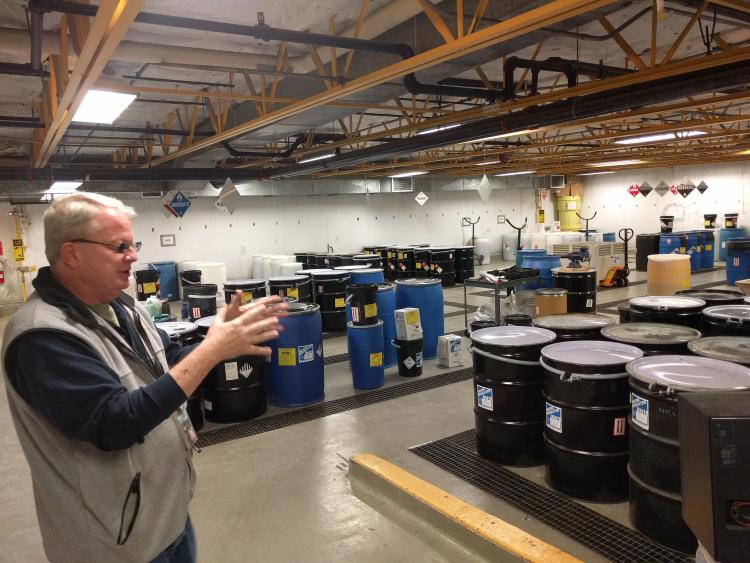Part 3: Waste Not, Want Not | EEF Funds Waste Disposal Project
[Editor’s note: This is part three of a four-part series looking at the student-led Engineering Excellence Fund.]

Ralph Bogle, a chemical treatment specialist in Environmental Health & Safety, describes processes that occur at CU Boulder's waste management building.
On the CU Boulder campus, between Coors Events Center and the parking garage, sits a modest building with a collection of hazardous waste that would impress a supervillain.
Stored in large metal drums, the chemicals sit in a room that is organized and smelly—an odor reminiscent of nail polish remover mixed with paint thinner.
Labeled the Environmental Health and Safety building, it processes the 50 tons of hazardous waste that campus produces each year. One student is interested in learning this process and bringing the knowledge to his fellow students.
“From a student’s perspective, this sets up a hands-on learning experience,” said Powell Hinson, a sophomore environmental engineering major.
Hinson’s proposal, funded by the Engineering Excellence Fund, is to video a tour of the facility as well as work demos of hazardous waste disposal into the curriculum of several engineering classes. The man he is working with is Ralph Bogle—an energetic gentleman who is excited not only by hazardous waste but also Hinson’s proposal.
“We have the whole cycle. We have research and teaching and labs and processes, but nobody ever thinks about the waste,” said Bogle, a chemical treatment specialist in the Environmental Health and Safety building. “They just think it all goes away. They put it in the machine, and it all goes away.”
Bogle illustrated that for engineers, it is particularly important to learn about waste disposal, as engineering generates more waste than most other colleges. Not surprising, since playing the trumpet doesn’t have much byproduct other than an accumulation of spittle.
“When you go into the private sector, hazardous waste is a big business,” Bogle said. “Because getting rid of it is so costly.”
Each of the neatly organized and stinky drums costs $400 dollars to incinerate, and that does not include labor, liability or transportation. To save on costs, Bogle treats some of the waste on campus, which is a large piece Hinson is interested in learning about.
“Eventually we’d like to have some demos and other student involvement, such as small-scale neutralization,” Hinson said.
Bogle treats “black water” and turns it into “grey water,” meaning he takes hazardous water and makes it the same level of toxicity as human waste. A classroom demo of this would involve adding pieces of activated carbon to a small vial of hazardous wastewater to pull the metals out of the water—a small scale of the much larger process happening under Bogle's watchful eye.
Tim Dittrich, a former PhD student at CU Boulder who graduated in 2012, worked closely with Bogle on the activated carbon method of waste management during his time at CU. Now he wants to create a better link between the students and their waste disposal. He found Hinson through the Society of Environmental Engineers, or SEVEN.
“Everyone goes to the Boulder wastewater treatment plant, but no one realizes there’s a facility on campus with a more specific task 100 feet from our labs,” he said. His goal is to bring waste management into the forefront of people’s thinking. Not surprising, as his job is cleaning up waste generated by the nuclear weapons program over the past 60 years.
“There’s a lot to think about when you’re designing an experiment and doing competitive research for funding,” Dittrich said. “But you need to make sure you’re disposing of waste in a way that you can defend.”
Hinson’s passion for this proposal, even early in the process, is inescapable. He not only credits Dittrich and Bogle, but also the EEF.
“When people think research, they think grad school,” Hinson said. “The more we open undergraduates to research opportunities, the better we’ll prepare them. Everything we do in school is so conceptual. Through research you can reinforce that what you’re studying is actually something you’ll enjoy, and EEF is a great catalyst for finding a, or making your own, research project.”
Tim Drugan-Eppich is an administrative assistant in the College of Engineering and Applied Science.

